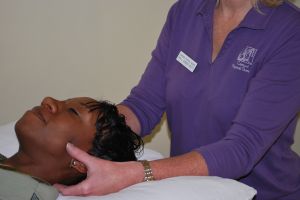
Tempormandibular joint disorder (TMJ) is a dysfunction of the hinge joint of the jaw. It is often associated with asymmetrical motion of the jaw, clicking or popping, or pain of the jaw, but neck pain, dizziness, and headaches are also associated symptoms.
Risk factors for TMJ can include trauma to the jaw, stress, teeth grinding or Bruxism, heredity, hypomobility and hypermobility, as well as gender. There are many types of TMJ including but not limited to disk-derangement disorders, displacement with/without reduction, degenerative joint disorders, inflammatory disorders, osteoarthritis, joint laxity, dislocation or subluxation, and myofacial dysfunctions.
There are many treatment options for TMJ pain by physical therapists:
- Massage and other manual techniques can reduce the stresses caused by tightened muscles, which can affect joint mobility and increase pain. Joint mobilizations to increase motion by stretching the joint capsule, correcting asymmetrical movement, and reducing pain and clicking.
- Modalities of cervical traction, TENS (electrical stimulation), and therapeutic ultrasound to increase healing and decrease pain. li>Exercises and body awareness of mechanical disorders including postural training to improve alignment and reduce stresses.
Postural training and exercise are an important part of the treatment of TMJ. Postural training provided by therapist can improve spinal alignment and reduce stresses on the cervical and thoracic spine. Training can include teaching proper opening and closing of the jaw, proper resting position of the jaw, proper alignment of the cervical and thoracic spine. Exercises and a home exercise program will be provided as part of a treatment program designed specifically for the patient based on their diagnoses and symptoms. All treatment programs can include a variety of methods including modalities, manual care, and strengthening exercises.
Ask us about your TMJ...chances are we can help!
Back To Services
